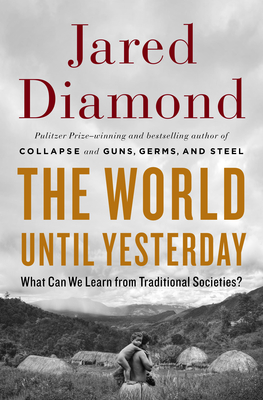So while teaching Cormac McCarthy’s Blood Meridian recently, I learned he’d been inspired by T.R. Fehrenbach’s Comanches: The Destruction of a People (1975), so I picked it up. Suffice to say it was a gripping read, as I had a zillion other things to do, and couldn’t put the book down until I reached the last page. If you’re interested in the history of the Southwest, and Texas in particular, I think you’d love the book. It’s more balanced and less histrionic than S.C. Gwynne’s Empire of the Summer Moon (2010), and more sweeping in scope; while Empire is focused mainly on the latter period of Comanche history in Texas—and particularly on its last great chief, Quanah Parker—Fehrenbach’s Comanches provides a greater context, particularly describing the Comanche raids and depredations in northern Mexico, which figures prominently in Blood Meridian. But I also found a connection of this bloody period of American history with the “traditional culture” worlds Jared Diamond describes in his new book, The World Until Yesterday. Simply put, in a world without “the rule of law,” interactions with strangers could have dire consequences. The horrible violence that unfolded during the Comanches reign in Texas and Mexico was in part due to their not being bound by any laws, but only by their own traditions, in which warfare and violent raids were a rite of passage for young men. Add into that equation that the Comanches were at times justly resisting the oncoming wave of Texan emigrants who eventually displaced them altogether. It’s given me a greater appreciation for the idea of “law and order,” something I was writing about in my recent novel, The Bird Saviors.

- October 2023
- September 2023
- September 2021
- April 2020
- September 2019
- May 2019
- August 2018
- February 2018
- January 2018
- October 2017
- August 2017
- June 2017
- May 2017
- March 2017
- February 2017
- November 2016
- October 2016
- May 2016
- April 2016
- March 2016
- February 2016
- January 2016
- November 2015
- October 2015
- September 2015
- June 2015
- May 2015
- April 2015
- March 2015
- December 2014
- September 2014
- August 2014
- May 2014
- March 2014
- February 2014
- January 2014
- December 2013
- November 2013
- October 2013
- September 2013
- August 2013
- July 2013
- June 2013
- May 2013
- April 2013
- March 2013
- February 2013
- January 2013
- December 2012
- November 2012
- October 2012
- September 2012
- August 2012
- July 2012
- June 2012
- May 2012
- April 2012
- March 2012
- February 2012
- January 2012
- December 2011
- November 2011
- October 2011
- September 2011
- August 2011
- July 2011
- June 2011
- May 2011
- April 2011
- March 2011
- February 2011
- January 2011
- December 2010
- November 2010
- October 2010
- September 2010
- August 2010
- July 2010
- June 2010
- May 2010
- April 2010
- March 2010
- February 2010
- January 2010
- December 2009
- November 2009
- October 2009
- September 2009
- August 2009
- July 2009
- June 2009
- May 2009
- April 2009
- March 2009
Recent Posts
- Aliens Among Us: Probing Hillbillies and Freaking Shut-ins, How Netflix’s “Encounters” and Hulu’s “No One Will Save You” Prep Us for the Coming Alien Apocalypse, Kind of
- My Life as a Bob Odenkirk Character: On How Watching Netflix’s Black Mirror episode “Joan Is Awful” Mimicked My Experience of Watching the AMC series Lucky Hank
- “Bobcats, Bobcats, Bobcats”: Animal Life and a Tribute to “Modern Family”
- “The North Water”: This Ain’t Your Daddy’s Moby Dick
- Day 25: On David Quammen's "Spillover": Terrific Book That Foretold Our Pandemic, Kind of
Recent Comments
No comments to show.
